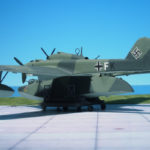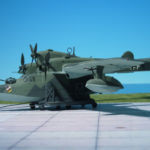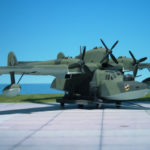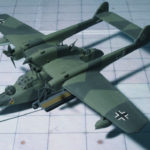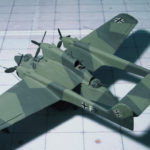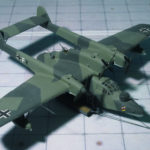TYPE: Long-range maritime reconnaissance flying boat
ACCOMMODATION: Crew of six
POWER PLANT: Three Junkers Jumo 205D liquid-cooled, vertically opposed diesel engine, rated at 870 hp each
PERFORMANCE: 177 mph at 19,700 ft
COMMENT: Originally developed under the company name of Hamburger Flugzeugbau, the type was initially designated the Ha 138. Its appearance was unique in its combination of unusual design features with its twin boom tail unit, short fuselage and trimotor engine configuration. The short hull, with its hydrodynamic step beneath and flat sides, earned it the nickname “Der fliegende Holzschuh” (“The flying clog”).
Three piston engines were used. The central engine was mounted above the wing, driving a four-blade propeller, while the wing engines were lower, with three-blade propellers. The pre-production prototypes were powered by various makes of engines ranging from 650–1,000 hp. The first standardized version, BV 138B-1, was powered by three 868 hp Junkers Jumo 250D two-stroke, opposed-piston aircraft diesel engines. The engine cowlings also had an atypical appearance, due to the unique nature of the vertical orientation of the six-cylinder opposed-piston Jumo 205 diesel engines, and resembled the cowlings of 4 or 6-cylinder inverted inline engines found on smaller civil and utility aircraft from the Jumo 205’s propshaft placement, emerging forward at the uppermost front end of the power plant.
The booms of the twin tail unit, much like the smaller Focke-Wulf Fw 189 twin-engine reconnaissance monoplane, extended horizontally from the rear of the outer engine nacelles.
For hydrodynamic reasons, the hull featured a distinct “turn-down”, or “beak” at the stern. Two enclosed, powered gun turrets, each mounting a single MG 151/20 autocannon, were located prominently at the bow and stern. A third, fully open Scarf ring-like emplacement, behind the central engine and both above and forward of the rear turret, mounted a MG 131 heavy machine gun covered fields of fire obstructed from the other turrets by the horizontal stabilizer.
In all, 227 examples of standard service variants of the BV 138 were built. The first such variant, Bv 138C-1, began service in March 1941. While non-standard variants carried a variety of armament, the standard variant featured two 20 mm MG 151/20 cannons, one in a power-operated bow turret and one in a power-operated stern turret, up to three 7.92 mm MG 15 machine guns, and a 13 mm MG 131 machine gun in the aft center engine nacelle. It could carry up to 500 kg of bombs or depth charges (under the starboard wing root only) or, in place of these, up to 10 passengers. Both the B-1/U1 and C-1/U1 variants had racks under both wings to double the offensive load.
Some examples of the BV 138 were adapted to specialized roles. The Bv 138 was tested with the oft-used Walter HWK 109-500 “Starthilfe” (RATO) jettisonable rocket pod, used in pairs, for shorter take-off performance. One anti-shipping variant carried FuG 200 “Hohentwiel” low-UHF band maritime search radar. The BV 138 MS variant was converted for minesweeping (suffix “MS” means “Minen-Suchgerät”, “mine-search” aircraft, and carried magnetic field-generating degaussing equipment, including a hoop antenna with a diameter equal to the length of the fuselage, which encircled the hull and wings, which was also used on certain models of the Junkers Ju 52/3m trimotor transport used for the same duty (Ref. 24).

